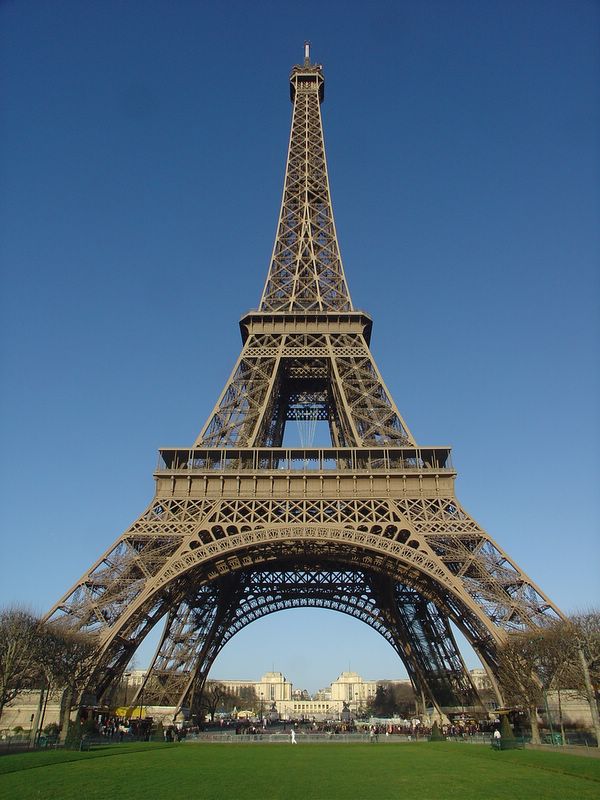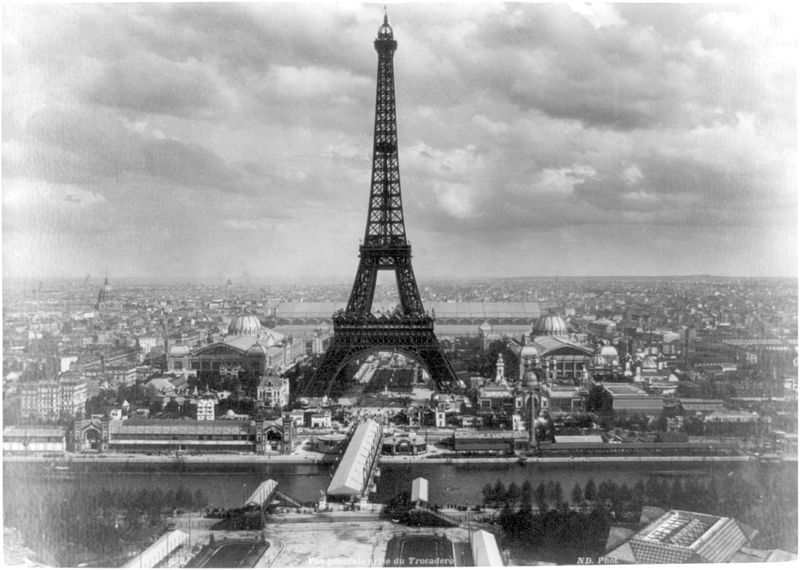The Eiffel Tower is the most famous landmark in France. Standing at 324 meters/1,063 feet tall, it’s the tallest building in France, and was the tallest in the world up until 1930. In 2015, there were nearly seven million visitors (6.91 million to be exact)!
To celebrate the 100-year anniversary of the end of the French Revolution, Paris decided to host a World’s Fair, or Exposition Universelle. The fair needed a monument built for the entrance though.
Maurice Koechlin and Émile Nouguier were two engineers working for Gustave Eiffel at the Compagnie des Établissements Eiffel. The two engineers worked together to create the first design of the landmark. Originally, Eiffel acted indifferent and not very excited about the project. So, Koechlin and Nouguier spoke with the head of Eiffel’s company’s architecture department, Stephen Sauvestre, to help with the original design. Sauvestre agreed to help. His main contribution to the project was adding decorative arches at the base, though he did add many other details to the tower.
When Eiffel was presented the new sketch with Sauvestre’s contributions, he agreed to purchase the patent. This time, he was much more enthusiastic and supportive of the tower. Eiffel had the new design put on exhibit in the fall of 1884 at the Exhibition of Decorative Arts. The following March, Eiffel discussed and presented the tower’s plans to the Société des Ingénieurs Civils.
In May of 1886 Édouard Lockroy, the new French Minister for Trade, had announced that because of the new budget for the exposition, the terms of the competition for the entrance monument were altered. With these new requirements, it was obvious Eiffel’s idea would be the one chosen. Later that month on May 12, officials met to examine all the entries. By June, Eiffel’s design was decided upon. His was chosen mainly because it included more details and was more practical than the majority.
The next year, Eiffel signed a contract that gave him money to build the tower on January 8, 1887. The sum of the money amounted to about 1.5 million francs (one French franc is equivalent to about $0.17). For the following twenty years after the exposition, all money made from the tower would go directly to Eiffel. Soon, he created a new company principally for the tower. Even with the money given to him by the government however, he would still have to put forth much of his own for the construction of his tower.
Many of the French were against Eiffel’s tower. It was critiqued widely. The Minister of Works and Charles Alphand, the exposition’s commissioner, were even sent a petition named “Artists against the Eiffel Tower”. On February 14, 1887, the petition was even published. Gustave Eiffel, in response, wrote that his tower would be the greatest and most grand built by man. He even compared to the pyramids in Egypt. Because construction had already begun, the petition was not approved. Many of the protesters later realized that the tower was not bad and had changed their minds. However, many did not change their views even after it was built and had been standing for quite some time.
On January 28, 1887, construction had begun. First, they had to do the foundations before really getting to work on the tower though. The foundations for the tower were not finished until late June. From there, construction really began. Overall, there were more than 1,700 basic drawings of the tower and 3, 629 with detail. More than 18,000 parts were required for the tower with 2.5 million rivets being used to connect the parts.
By March 20, 1888, the legs and first level were finished. The second level was completed in August and on March 15, 1889, the tower was completed thanks to the three-hundred hired construction workers.
Lifts were needed for the tower by the time the exposition came around. It was possible to make your way to the first level by way of stairs or climbing, but to go higher a lift would be needed. Luckily, the lifts were easily constructed for the the first level because of the design of the legs. Roux, Combaluzier & Lepape, a French company, were tasked with building lifts for two of the legs.
However, the company would not build the lift for the second level. No French company would, as a matter of fact, because it would be impossible to build a straight lift. Otis Brothers & Company would eventually send Eiffel their idea for the lifts. Their proposal was originally rejected. Because no other companies sent in proposals, Otis Brothers & Company was chosen to install the second level lifts in July of 1887.
Almost two years later in March of 1889, construction was finished. On the final day of the month, government officials were given a tour to the top of the tower by Eiffel. The lifts were still not entirely finished though, and the officials were required to climb by way of staircase. This proved to be quite a challenge because of how big the tower really was. It took over an hour. Many even stopped at the first level. Only a few of the men accompanying Eiffel climbed to the third floor with him.
The Exposition Universelle opened May 6, 1889. Nine days later, with the lifts still not entirely done, the Eiffel Tower opened to the public. Many of the exposition’s attendants were so excited about the tower, that they took the challenge and climbed all the way to the top. Just less than 30,000 people, actually.
When the exposition closed on October 31, 1889, the Eiffel Tower had had exactly 1,896,987 visitors. Despite all the critiques and attempts to stop construction at first, the tower was an instant success. On the third floor of the tower there was even a post office. That way visitors were able to send postcards to show that they had gone to the top. Eiffel also had his own personal apartment on the third floor.
Originally, the tower was only supposed to be kept up until 1909, so twenty years after it was completed. Because the tower had been useful for communication, especially during the upcoming wars, it was kept up.





